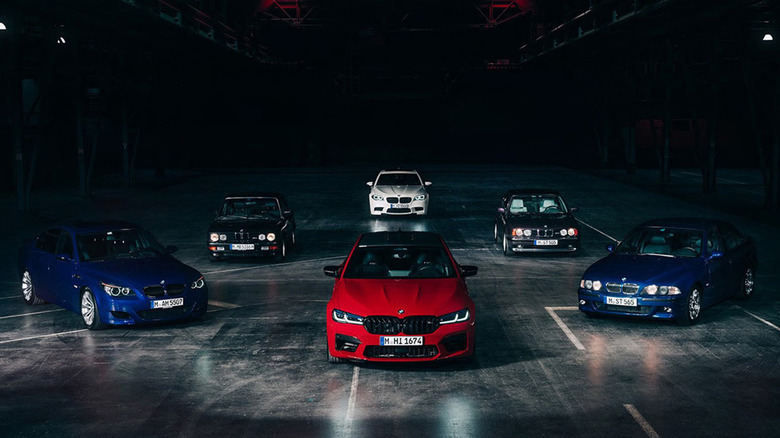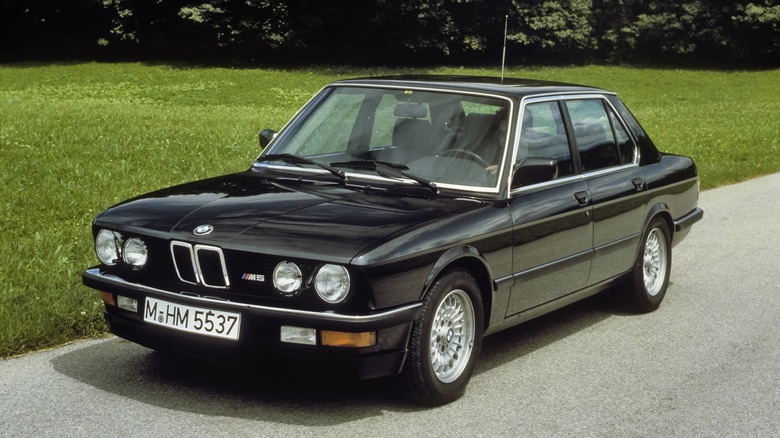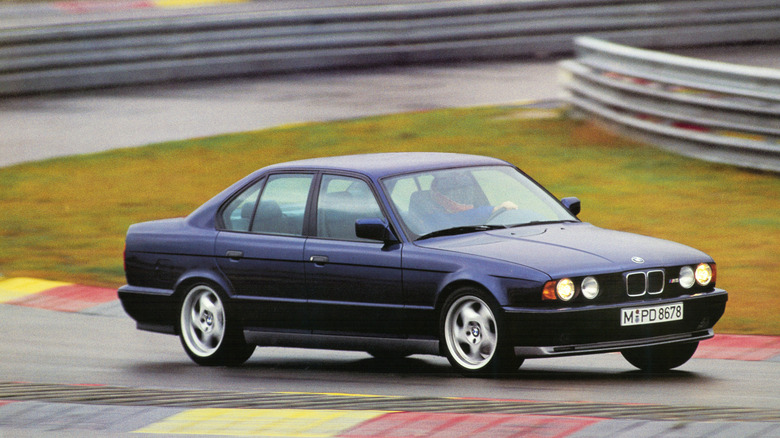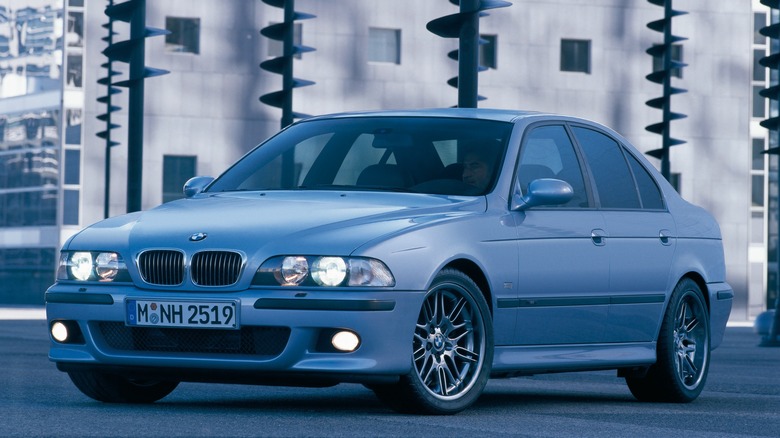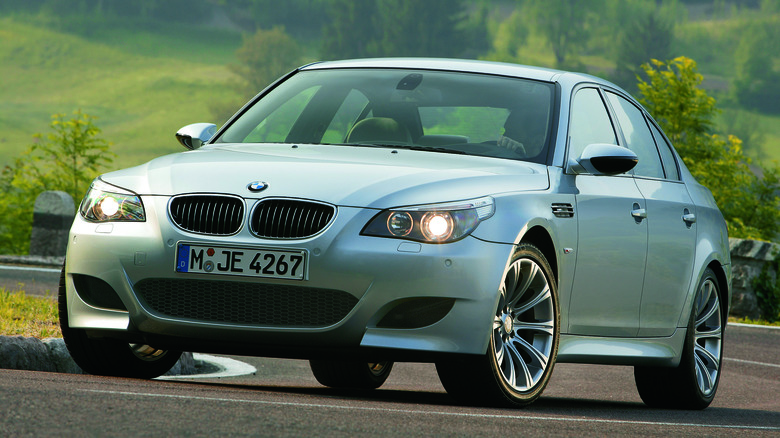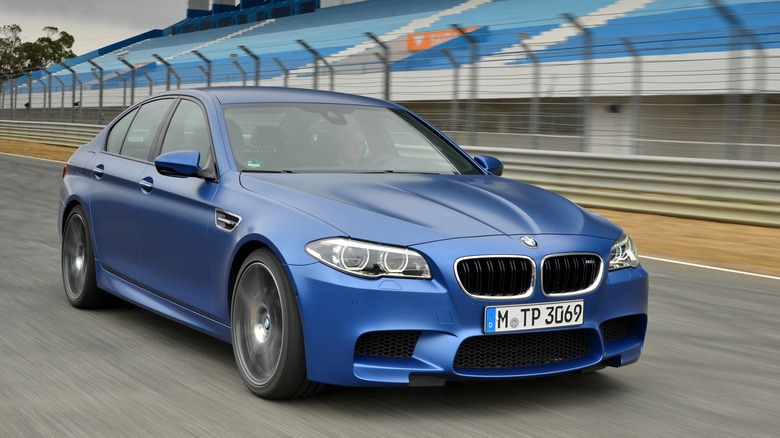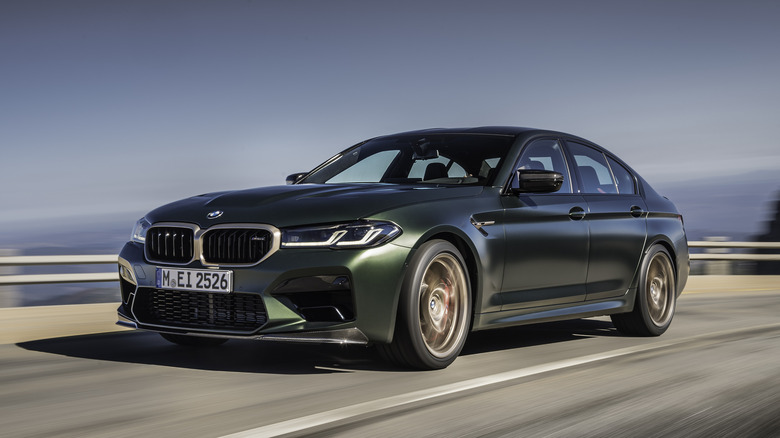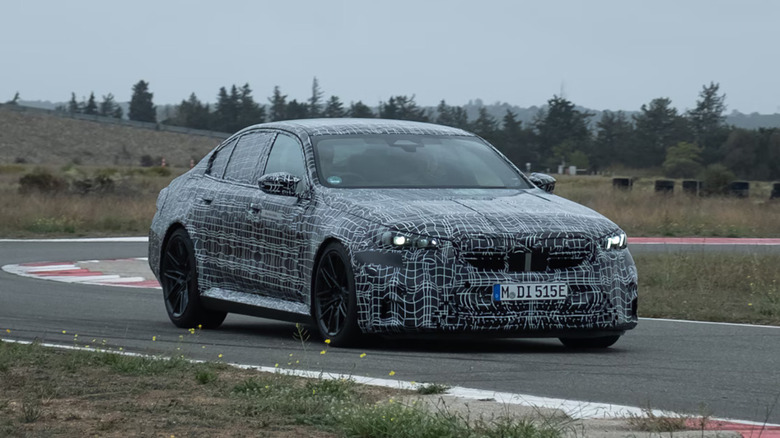BMW M5 Turns 40: Here Is How It Evolved Over The Years
The BMW M5 is iconic in the high-performance executive car segment, showcasing the brand's ability to build ever-better driver's cars. Always incorporating motorsport bits but without taking away from the luxurious feel of the regular 5-Series, the M5 is the quintessential super sedan. Over the years, it has become so fast and capable that it can compete with modern supercars. It's super-quick, fun to drive, yet comfortable enough for long journeys.
This year, the M5 line turns 40 years old, spanning through six generations. Each era of BMW's super sedan brought something different to the table, but the main focus was always perfectly clear: building "The Ultimate Driving Machine." That also meant beating its Mercedes-Benz and Audi rivals in a performance race that continues to this day.
However, not everything that BMW has changed over the years has made enthusiasts happy. Chasing acceleration figures, BMW's "M" division killed the manual transmission. Moreover, purists lament the fact that the latest M5s feature turbocharged engines, rather than naturally aspirated ones. The addition of hi-tech features also added a lot of weight, too. Still, that doesn't diminish the prestige of the M5. Born from a desire to compete and offer its customers a unique driving experience, the M5 remains an enthusiast's dream. With that in mind, here is the path it took to reach the super-sedan pinnacle.
1985 BMW M5 E28
The BMW M1 was one of the coolest cars ever made, but it wasn't terribly successful. Little did anyone know, the M division was only warming up. The real treat came in 1985 at the Amsterdam Motor Show when BMW shocked the world with the M5. Featuring an improved version of the M88 inline-6 engine from the M1 sports car, the first-ever M5 promised speed analogous to sports cars from the era. BMW's motorsport division didn't forget about the driving experience, too. The car featured an upgraded sporty suspension, a limited-slip differential at the rear axle, and a five-speed manual.
The Bavarian giant's M division had the numbers to back up the first M5's legendary status. Producing 282 hp (in the European version) and 250 lb-ft, the hand-assembled 3.5-liter engine catapulted the M5 E28 to 62 mph in just 6.5 seconds and to a top speed of 152 mph. These were Earth-shattering numbers in the 1980s, especially for a large executive car that was roomy inside and featured a huge 620-liter trunk. The U.S.-spec M5 E28 had a slightly detuned, 256-hp engine due to emission regulations but could still reach 60 mph in 6.3 seconds.
Numbers aside, the M5 E28 showed its true finesse in real-world driving. With balanced handling, strong lateral grip, excellent highway stability, and best-in-class braking, the M5 E28 redefined the sport sedan category. The sweet-sounding inline-6 engine only adds to the holistic super-sedan experience. Even so, the M5 E28 was merely the opening salvo.
1988 BMW M5 E34
The first-gen M5 was so influential that upgrading its recipe was a challenging task. However, as the public was still drooling over the M5 E28, BMW worked on the next-gen super sedan based on the third-gen 5-Series. The plan was to improve the M5 in every area and again make it a best-in-class proposition.
The 3.5-liter inline-6 was massaged to 315 hp, which cut down the 0-62 mph time to 6.3 seconds. Furthermore, BMW implemented shorter springs, lowering the M5 by 0.8 inches compared to the regular 5-Series. Stiffer dampers and larger anti-roll bars were added to control body roll, along with larger brakes for shorter stopping distances.
It worked, and the M5 was once again the quickest sport sedan, while also boasting the shortest stopping distances and offering balanced handling. BMW was careful not to ruin the 5-Series comfort attributes, so the M5 E34 remained a comfortable car over bumpy roads. But this was a driver's car first and foremost, despite also being offered as a wagon from 1992. Thus, BMW equipped it with speed-sensitive variable-assist steering and a slick-shifting five-speed manual, enhancing driver involvement.
Still, this wasn't even the best version of the M5 E34. In 1992, BMW's M division introduced a facelifted M5 with a larger 3.8-liter engine, producing 340 hp and an optional six-speed manual. As a result, this version sprinted to 62 mph in just 5.9 seconds, again undercutting its rivals. Not only that, but it sounded glorious when revved to its 7,000-rpm redline.
1998 BMW M5 E39
The first two generations of the M5 had inline-6s because they were motorsport-derived engines, unlike the luxury-oriented V8. However, that was about to change, as the M division was working on a 4.9-liter V8 rocket to launch the M5 into the stratosphere. With 400 hp and 369 lb-ft on tap and a standard six-speed manual, the M5 E39 reached 62 mph in just 5.3 seconds. Real-world acceleration tests showed a 0-60 mph time of 4.7 seconds, which in 1998 rivaled many supercars.
Although derived from BMW's regular 4.4-liter V8 from the era, the unit in the M5 E39 is full of motorsport goodies. Notably, it features individual throttle bodies, one of the unique traits that made M Power engines so good in the 1990s. It also made the V8 sound like a racecar engine. BMW's VANOS variable valve timing system was also onboard, along with a relatively high 11.0:1 compression ratio and a free-flowing exhaust system.
Still, power was again only a part of the equation. The holistic approach to the super-sedan formula really differentiated the M5 E39 from its rivals. Competitors like the Mercedes-Benz E55 AMG and Jaguar XJR were not only slower, but less fun to drive. The M5 E39 handled better in the corners, providing a higher grip. It also had a more precise steering and the slickest-shifting gearbox in its class. Its more rounded, bulbous body was the finishing touch that helped the M5 E39 stay above the competition.
2005 BMW M5 E60
BMW's M division entered the F1 championship in 2000 as an engine supplier for Williams and in 2006 as a factory team. To celebrate its Formula One effort, the Bavarian brand needed a halo car to help enthusiasts relate to the era's crazy, V10-powered F1 cars. Enter the M5 E60 — perhaps the craziest M5 BMW has ever created.
For this generation, BMW added two more cylinders, creating a V10 super-sedan that sounded like a racecar. The 5.0-liter was a powerhouse, too, pumping out 507 hp and 384 lb-ft of torque and catapulting the M5 to 60 mph in just 4.2 seconds. Without the 155-mph speed limit, the M5 E60 could purportedly reach 205 mph! Adding to its appeal, the 8,250-rpm redline made it feel like a real racing machine. All of that was packed in a stylized executive sedan with a luxurious and roomy interior. Unsurprisingly, it's one of the most sought-after BMWs.
The M5 E60 wasn't without controversy, though. While BMW offered a six-speed manual in the U.S., most cars were sold with the SMG automated manual with F1-like paddle shifters. The new gearbox performed well when pushed hard, providing quick gear changes, but it was otherwise jerky. It wasn't very reliable, either, though the same can be said for the V10 jewel under the bonnet. Thus, owning an M5 E60 is quite a tricky proposition, with careful maintenance required to keep it running. You will get unparalleled thrills while driving it, though.
2011 BMW M5 F10
The M5 F10 had big shoes to fill and it succeeded, at least as far as numbers are concerned. BMW employed a forced induction engine for the first time in an M5, with a new 560-hp 4.4-liter twin-turbo V8 providing much more power than the E60, with the Competition package cranking that number to 575 hp. However, the increase in torque was far more impressive, with the more powerful version delivering earth-spinning 502 lb-ft at anywhere from 1,500 to 6,000 rpm.
All of this made for brutal acceleration throughout the whole rev range and a 0-60 mph time of 3.7 seconds. But straight-line catapulting is only a part of the F10 story. For the first time, this generation received a seven-speed dual-clutch transmission with lightning-quick shifts and smooth operation. Purists weren't forgotten, though, as BMW continued to offer a six-speed manual. Moreover, the M5 F10 featured a hydraulic power steering, as opposed to the electric one in the regular 5-Series, thus offering more engagement. Better brakes and a stiffened suspension were present, too.
Still, the F10 is the first M5 to flirt with the 2-ton barrier, weighing 4,354 pounds unloaded. M division's expert engineers were able to hide the super sedan's weight to a degree, but there was no escaping the fact that the M5 had become fat. In addition, the twin-turbo V8 lacks the sound of its predecessor. So, while it's lightning-quick, luxurious, and comfortable, the F10 misses the sense of occasion of its predecessors.
2017 BMW M5 F90
The current M5 uses an improved version of the 4.4-liter twin-turbo V8, massaged to 600 hp and 553 lb-ft of torque available between 1,800 and 5,600 rpm. For the first time in an M5, the F90 also comes standard with BMW's xDrive AWD system, allowing for a 0-60 mph time of just 3.2 seconds. And if those numbers weren't absurd enough, the most powerful M5 CS has 627 hp and hits 60 mph in just 3 seconds.
BMW also employed some weight-saving practices in this generation, like a carbon-fiber-reinforced plastic roof. Still, the M5 F90 is not what you'd call a light car, with the CS version weighing 4,343 pounds. The company also opted for a ZF-sourced eight-speed automatic instead of the dual-clutch seven-speed of the previous generation. Unfortunately, for the first time, no manual was offered, which annoyed BMW purists.
The F90 lacks the involvement of the M5s of yore; its engine doesn't offer the auditory nirvana that M5 owners are accustomed to, and the steering feels almost lifeless. Even so, it's by far the most capable sports sedan on today's market. The M5 F90 is a rocket in a straight line, corners like it's on rails, and offers a luxurious interior with technology rivaling that of an Airbus A380. Besides, with all recent safety and emission regulations, driving involvement is put on the eraser board anyway. The only path BMW could've taken is to strip down the 5-Series of all luxuries, which would not have gone over well with its customers.
What can you expect from the 2025 BMW M5?
Definitely not a more engaging M5. The days of a light-ish M5 with a sonorous engine and a manual gearbox are long gone. Today, electrification is the name of the game, and we fully expect BMW to use it in the next M5, based on the recently-announced 2024 5-Series. Also, expect a huge power bump, as the M5 will now have to compete with the onslaught of super-quick EV sedans, like the Tesla Model S Plaid and Lucid Air Sapphire. There is also the fully electric high-performance version of the 5-Series, the i5 M60, which has 593 hp on tap, enough to reach 60 mph in 3.7 seconds.
Fortunately, BMW already showed its cards when it launched the XM SUV, which is considered its halo vehicle. You can expect its tech to trickle down to other models in the lineup. The super-SUV has a plug-in hybrid powertrain consisting of a 4.4-liter twin-turbo V8 and an electric motor. As a result, it has up to 738 hp, with the next-gen M5 probably producing 735 hp and stupefying 735 lb-ft of torque. This ridiculously potent powertrain should result in a 0-60 mph time of around 2.5 seconds, aided by BMW's excellent xDrive AWD system. But that would be only the beginning — anticipate the CS version to have even more power.
BMW will undoubtedly upgrade the M5's suspension and brakes. Still, all those plug-in hybrid bits, particularly the battery, will inevitably add weight, with reports saying the penalty will be around 400 pounds. Ouch!
